Егер сіз қырғыздың «Манас» жырының қысқаша мазмұнын оқысаңыз, бірде-бір әйел бейнесін кездестіре алмайсыз. Бұл эпос абсолют түрде әкені, жауынгерді, ел қорғаушы ерлерді дәріптейтіндей көрінер, алайда мүлде олай емес. Сексизм деуге келмес. Әркім шама-шарқынша ұғынады. Бар болғаны эпосты мән беріп оқысақ жеткілікті.
«Манастың» жарты миллион тармағын оқыған адам эпостың ішінде көптеген әйел бейнесін көре алады. Манасшылар жырлағандай, макрокосмоста әйел рөлі ер адамнан кем емес. Ол жер бетіндегі халықтарға тән табиғат-ананың ежелгі культінен бастау алады. Баланы дүниеге әкелудің құпиясы мифологияда көрініс тапты және тылсым күштермен байланыстырды, әрине, олар көбінесе әйел бейнесінде сипатталды. Жыршылар әйелдердің ермен тең дәрежеде шайқасқа қатысқанын, кейде олардың батылдығы ерлерден асып түскені туралы да жырланады. Сонымен бірге «Манаста» дәстүрлі қырғыз қоғамына тән әйелдердің мінсіз бейнелері көрініс тапты. Олар эпостың үш бөлімінде («Манас», «Семетей», «Сейтек») әйел кейіпкер Қаныкей бейнесінде толық бейнеленген.
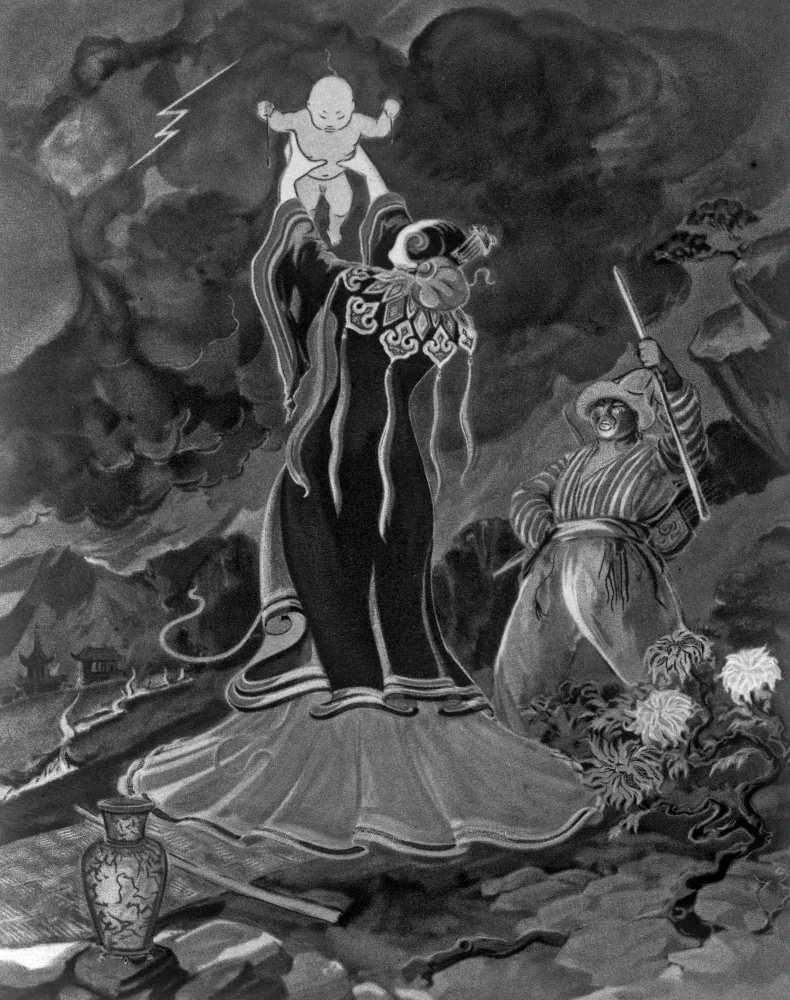
«Манас» жырына жасалған иллюстрация. Г.Петров. 1956/РИА Жаңалықтары
Қызы мен қалыңдығы, әйелі мен анасы, өмірінің барлық ыстық-суығында ер кейіпкерлермен бірге болады, ерлікке жетелейді және қауіп-қатерден, кейде көзсіз батылдықтан сақтандырады. Ата-бабамыз құдай-ананы, көшпелілердің Мадоннасын, әйелдің мінсіз образын осы Қаныкей бейнесінде көрді.
Қаныкей маңызды кейіпкер болғанымен, эпостағы жалғыз әйел бейнесі емес. Ертегі әлемін, қарапайым тұрмысты және бір-бірімен тығыз байланысты тарихи оқиғаларға толы «Манастың» эпикалық әлемінде архаикалық құдай-аналар да, перілер де, батыр қыздар да бар. Бұл әйел типтері арқылы жер бетіндегі оқиғалардың керемет, жұмбақ, сюрреалды бастауы баяндалады.
ҚҰДАЙ-АНАЛАР
Құдай-аналық принципті бейнелейтін тіршілік иелеріне киелі Бұлан — Ақ-Марал, қасиетті бұғы — Ақ-Бұғы және Ұмай-ана жатады. Бір қызығы, Ақ-Марал мен Ақ-Бұғы құдайлары өздерінің жануар сипатын әлі жоғалтқан жоқ, ал Ұмай-ана Орталық Азиядағы түркі халықтарына баланы дүниеге әкелетін Құдай және босанған әйелдерді жебеуші ретінде кеңінен танымал.
Зооморфты құдайлар табиғат-ананың жұмбақ күші ретінде батырға қорған болды, көмек берді, физикалық күш пен батырлық қасиеттер дарытты. Сәби кейіпкерге құдайдың сүтін беріп, оған тылсым күш берілуінде ерекше мистикалық мән бар.
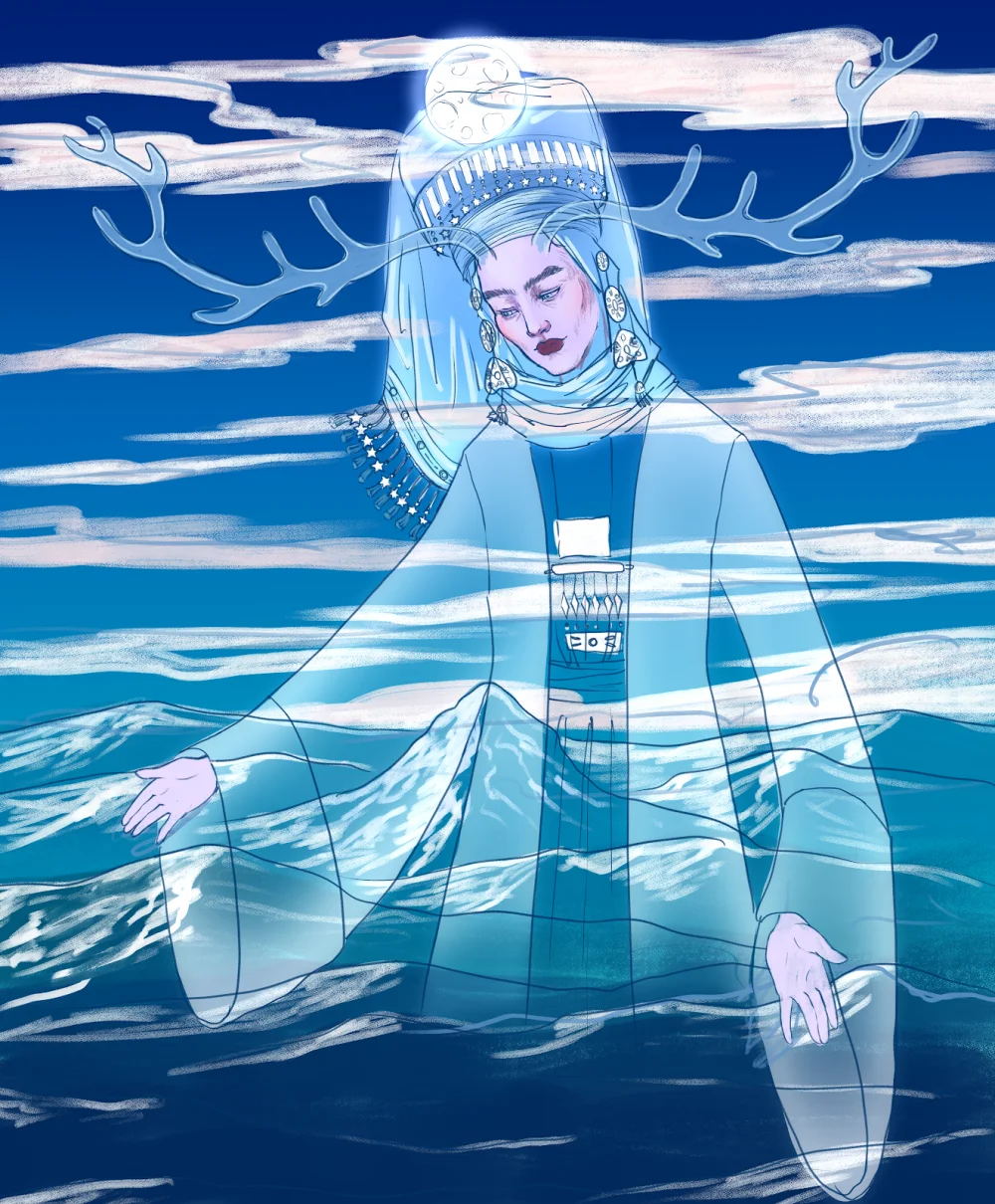
Ұмай ана/Qalam редакциясы
Сонымен Киелі Бұлан дастаншы С. Қаралаевтың «Семетей» дастанындағы «Қаныкейдің сәби Семетей мен қайын енесі Чыйырдымен бірге Бұқарға қашуы» сюжетінде кездеседі. Онда: елсіз тау ормандарын аралап, Семетейді өлтірмекші болған қайын інілерінен жасырынып, шарасыз халге түсетіні бар. Амалы құрыған әйелдер ағаш түбінде қатты ұйықтап кетіп, баладан көз жазып қалады. Зәресі ұшқан екеуі кішкентай Семетейді іздеуге көшеді. Әне-міне дегенше Қаныкей оның алтын мүйізді Киелі Бұланды еміп жатқанына куә болады:
Баягы чет алдынкы белестен,
Алтын Мүйүз Ак Марал
Туура тартып баланы
Эмизип турган көрүнөт…
Бир эмчегин эмгиче
Бир эмчеги Маралдын
Ийип турган кези экен.
Эне кылып Маралды
Билип турган кези экен.
Элдеп-селдеп эмчегин,
Эне кылып Маралды
Соруп турган кези экен.
Қазақша жолма-жол аудармасы:
Баяғы алдыңғы шет белестен
Алтын мүйіз Ақ-Марал
Емірене баланы
Емізіп тұрған деседі
Бір емшекпен емізсе,
Бір емшегі Маралдың
Иіп тұрған кезі екен.
Анам деп сол Маралды
Біліп тұрған кезі екен,
Ана қылып Маралды,
Жайбарақат емшегін,
Сорып тұрған кезі екен.
Қаныкей көргенін жақсы өзгерістердің маңызды оқиғасына балайды. Ұлым батыр болады, туған жері Таласқа оралады, жауынан әке кегін қайтарады, халқына бас болады, яғни тағдырына жазылған тәлейін орындайды деп бойына ерекше бір рух бітеді.
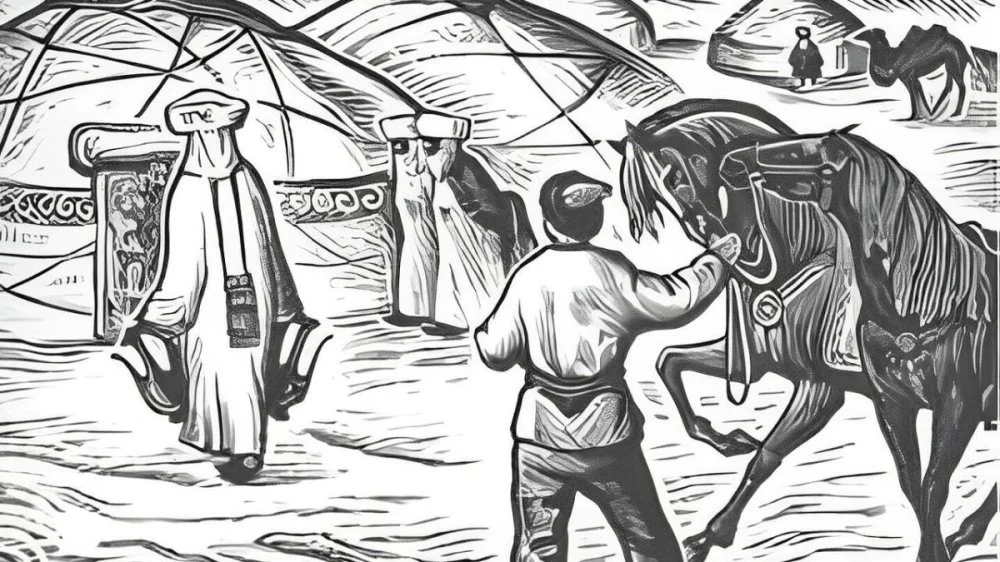
Манас жырына жасалған иллюстрация. Герцен Теодор Теодорович 1935-2003 , 1972/National Museum of Fine Arts Gapar Aitiev
Әкесін, туған жерін тастап, қайда барарын білмей жалғыз өзі тауда қаңғып жүрген қытай ханзадасы Алмамбет батырдың тығырыққа тірелуіне байланысты зооморфты Ақ-Бұғы бейнесін кездестіреміз. Оның тәлейіне, Ақ-Бұғы пайда болып, салт аттыны қазақ ханы Көкшенің жеріне қарай айдайды. Дәл сол жерде ол әйелі Ак Эркечтен Манас туралы біліп, сол әйелдің кеңесімен Манасқа қарай аттанады.
Тілі жоқ Бұғы Алмамбетті Манастың бір емшектен сүт емген бауыры және жақын досы болуға, сөйтіп жаңа Отан табуға алдын ала жоспарланған жолмен әкелгендей болды. Бұғылардың осы қызметтері Бугу тайпасының жаратушысы анасы Ақ-мүйізді кейуана («Ак мүйүздүү байбиче») туралы ауызша әдебиетінде жақсы сақталған, олар Енисей өзенінің бойында екі жетімді құтқарып қалып, олардың Тян-Шань тауларының сілемдеріне көшуіне жәрдемдескен, өз тайпасының негізін қалап, жаңа Отанын табады.
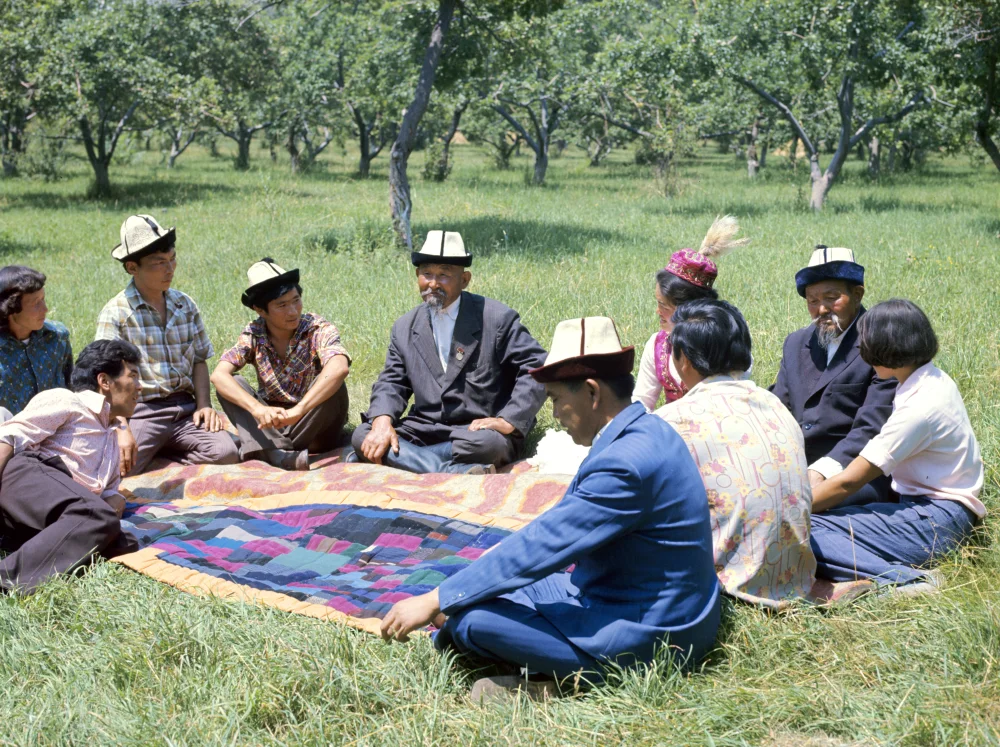
Манасшылар жастарға қырғыз батырлары Манас, Семетей және Сейтек өмірін жырлауда. Қырғызстан, 1979/РИА жаңалықтары
Қырғыз эпосындағы зооморфтық құдайлар сыртқы келбеті адамға ұқсас якут олонхо Аан Алахчын, Айыхсыт, Иейехсыт, Алтай тауының ханымы «Маадай Қара», ақ кемпір Хуу Инейге жақын. Хакастардың Алтын Арыг және басқа да түркі-моңғол эпостары туралы, Оңтүстік Сібір туралы аңыздарындағы кейіпкерлері де ұқсас. Олардың бәрінің функциялары ортақ.
Олар болашақ батырларды сәби кезінде немесе балалық шағында емізіп және осылайша олардың бойына ерекше батырлық қасиеттер дарытады. Олар кейіпкердің өмірлік мақсатына жол ашып, тағдыр сынына тап болмас бұрын батасын береді. Алайда зооморфты құдай-аналар қырғыз эпосының ең көнесі және мифологиялық жаратушы құдай-аналардың алғашқы бейнелері.
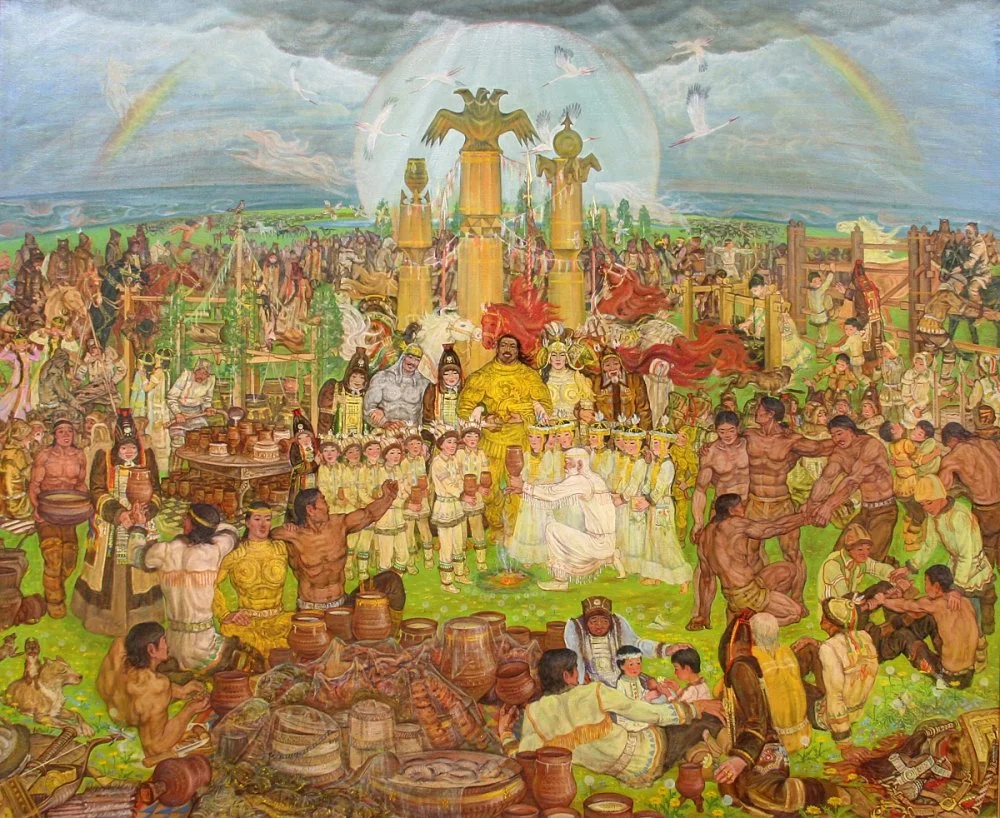
Степанов Тимофей Андреевич. Ортаңғы әлем. Ысаах. Якут эпосы – Олонхо. 1980/Google arts
Манасшы С. Орозбаковтың нұсқасындағы Ұмай-ана құдайы эпоста анасының босануы кезінде, яғни Манас дүниеге келген кезде кездеседі. Құрсақта жатқан құлықсыз нәресте Манас пен Ұмай-ананың арасында диалог болады. Онда Манасқа жарық дүниеге шығуға бұйрық береді, ал нәресте өзінің үлесі туралы, яғни тағдырым қалай болады деп, мақсат-мұраты туралы сұрайды, егер тағдыры оған сәйкес келмесе, дүниеге келмейтінін айтады. Бірақ жігерлі Ұмай-ана Манасты шапалақ беріп, құрсағынан шығаруға мәжбүр етеді. Бұл шағын диалог Ұмай-ананың Ақ-Марал, Ақ-Бұғы, Алтай тауының ханымы, Хуу Иней, Аан Алахчын сияқты қамқор тәңіриялармен және түп-аналармен тікелей байланысын айғақтайды.
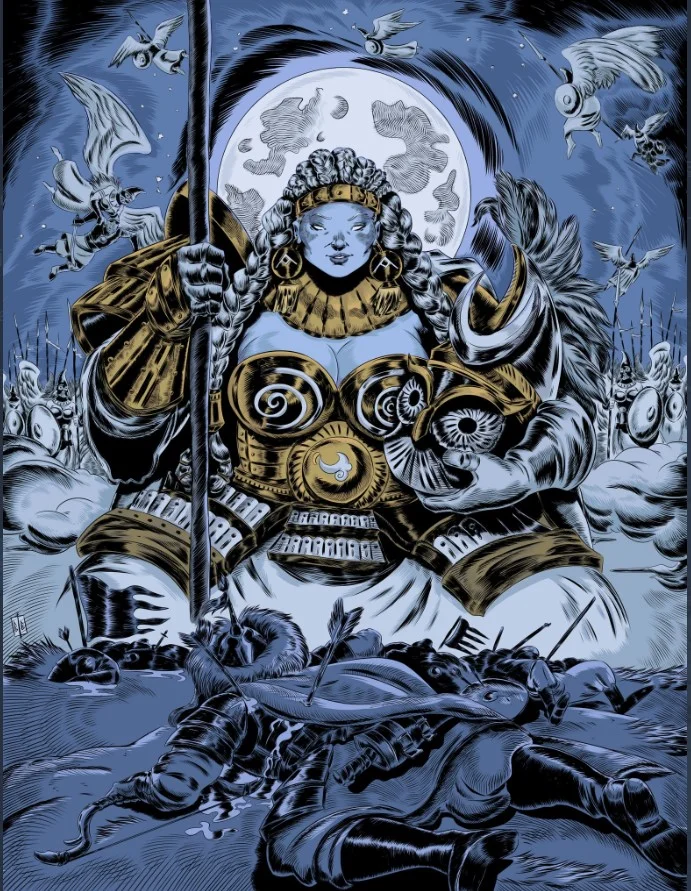
Ұмай ана. Барту Бөлүкбашы/Wikipedia Commons
Саха, Алтай және басқа да эпостарда құдай-аналардың қамқорлығы батырды бағып-қағуда, ат қоюда, сауыт-сайманын дайындауда, сиқырлы ат пен қару-жарақ беруде де көрініс табады. Сонымен бірге олар сапар алдында оған ақылын айтып, тіпті батырды өлімнен де құтқара алады. «Манаста» бұл функциялардың көбі әлдеқашан басқа әйел кейіпкерлеріне, яғни батырлардың әйелдері мен аналарына берілген. Уақыт өте ертегі әлемі шынайы дүниеден алшақтап барады, бірақ, әрине, толығымен жойылған жоқ.
ПЕРІ ҚЫЗДАР
«Манастағы» сиқырлы қыз немесе перілерге мыналар жатады: Аруке — Қаныкейдің бала күнгі досы және Алмамбеттің әйелі, Күлчороның шешесі (С. Орозбақов); Айчүрөк — Семетейдің келіншегі мен әйелі, Сейтектің анасы (С. Қаралаев); пері Көкмончок, әпкесі Айчүрөк (С. Қаралаев), Қараберк (М. Чокморов); Нақылай — оңтүстік нұсқалары бойынша Манастың келіні мен әйелі (Чал Сыдықов, Акун Тәшев). Оларға Қошой батыр (С. Орозбақов) туралы әңгімелерде жартылай сиқырлы «аяр» әйелдері де қосылады.
Бұл кейіпкерлердің адамдық та, құдайлық та сипаты бар, олар құсқа, балыққа, тасқа немесе қауырсынға айналатын сиқырлы қабілеттерге ие; ғажайып сиқырларының көмегімен олар жаз мезгілінде қар жаудырып, егістіктер мен өзендерді батпақ пен орманға айналдырады; пері қыздар жараланған батырларды емдеп жазады; олар өздерінің ерекше сұлулығымен көз жауын алып, көрген жанның бәрін аң-таң қылады.

Перілер/Qalam
Семетейдің жары Айчүрөктің бейнесіне толығырақ тоқталайық. Ол Үргеніш билеушісінің қызы, бірақ оның қиялындағы әкесі оны әдетте ғажайып әсем қыз-келіншектер уақыт өткізетін мекеннен тауып алып, өсірген екен. Пері қыздардың негізігі әрі маңызды функциясы — тағдырдың жазуы бойынша оқиғаларды реттеу мүмкіндігі. Бастапқыда Айчүрөк Семетейдің бәйбішесі Чачыкейден Семетейге тоқал болуға сұранады, алайда қызғаншақ әрі тәкәппар Чачыкей көнбей қояды.
Ол Айчурөкті қуып жібереді және оның күйеужігітпен кездесуіне жол бермейді. Сонда ғана Айчүрөк өзінің сиқырлы қабілетіне жүгініп, аққуға айналып кетеді де, батырларды бағалау үшін ұшады; содан кейін Семетей әскери киімін жөндеуге керегін алсын деп мамыққа айналады; аңшы құсты күйеужігіттен құда түсу үшін алып кетеді; күйеужігіт өзіне оңай жетсін деп Үргеніштің маңайындағы арнасынан тасыған өзендерді құрғатып тастайды.
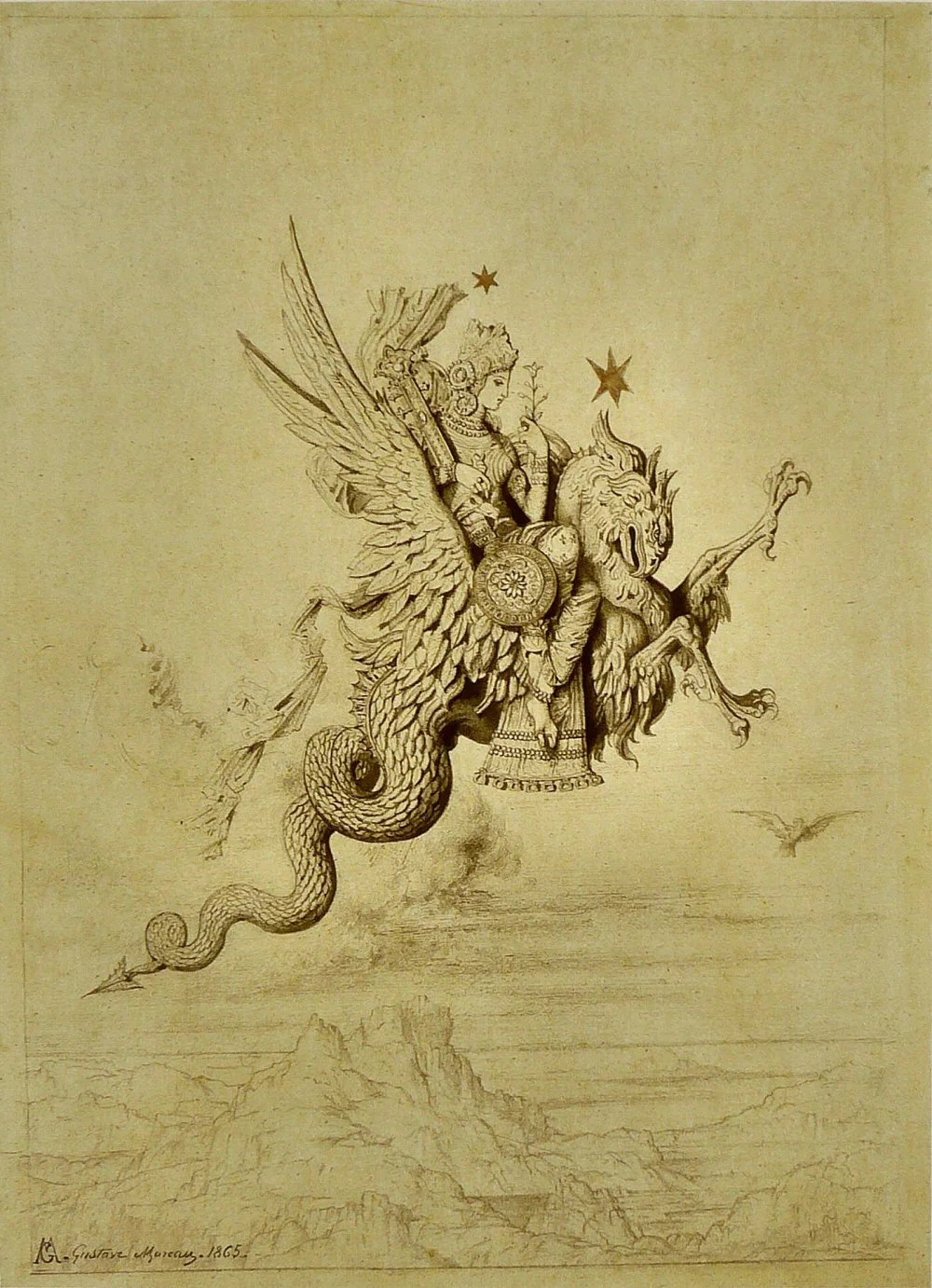
Густав Моро. Пері. 1865/Wikimedia Commons
Қазақтың, түрікменнің, өзбектің және басқа да халықтың ұлттық эпостарында батырлардың қалыңдықтары, әрине, сұлулығымен танымал. Дастаншылар кейіпкерлердің сыртқы келбетін сипаттағанда аянып қалмайды. Сұлулардың портреті сан түрлі теңеулермен, метафорамен, эпитеттермен және гиперболалармен жасалады. Арулардың бет әлпетін, шашы мен қасын, жүріс-тұрысын, көзін, білегін, тұла бойы тұрпатын суреттегенде табиғат құбылыстарына, өсімдіктер мен жануарлар әлеміне, халық құнды деп тапқан мәдени объектілерге негіздейді.
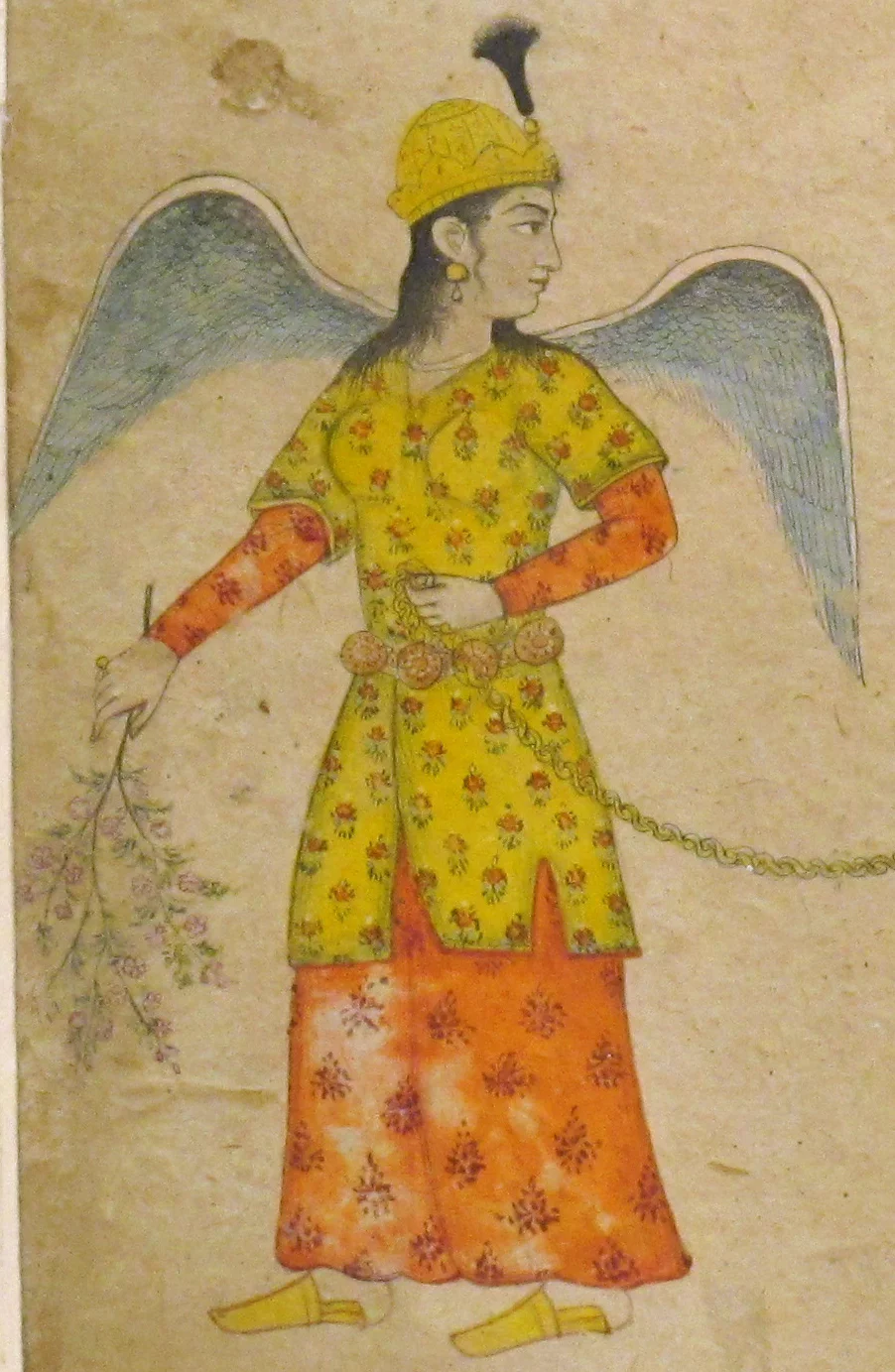
Пері. Үнді миниатюрасы. 19 ғасыр, Бхопал Археологиялық музейі/Wikimedia Commons
Айчүрөк бейнесі өзінше ерекше, тіпті атының өзінде («ай үйрегі», «айдай сұлу»), мифологиялық шығу тегі туралы сілтеме мәліметтер бар. Оның бет-әлпетін айдың нұрымен салыстыру — ежелгі адамдардың дүниетанымынан бастау алатын, сұлулықты күн, ай, жұлдыз секілді космологиялық құбылыстармен, бейнелі элементтермен байланыстыра суреттеген:
Сол қыздардың ішінен,
Ай жүзіндей жарқылдап,
Ахунның қызы Чүрегің
Шықты бері бөлініп,
Жүрген сайын жарқырап
Алтыннан қылған тұмарша
Ақ мойнында шарқылдап,
Жалт бұрылып қараса,
Адамның көңілі бөлініп.
Назар салса, мөлдіреп
Перизаттай көрініп.
Келе жатыр жарқылдап,
Алпыс ашқыш, қырық седеп
Алқымында жарқылдап,
Мүскі жұпар иісі аңқып,
Жадырап көңіл бөлініп,
Көк сілеусін, құндыз бөрік
Ахунның қызы бейбақтың
Шекесінде көрініп.
Епсіз, сұлу жеңгеңнің
Шекерден тәтті сөзі бар.
Есінен танар көрген жан.
Үстіңгі ерін тұсында
Түрігірек жері бар.
Бұл түгенген Чүректің,
Қай жерінің кемі бар?
Өлген батырды пері қыздардың қайта тірілту мотиві Оңтүстік Сібір мен Алтайдың түркі-моңғол эпостарында кең таралған. Оның мифологиясын «Манас» жыры да сақтап қалды. Өзен жағасында оқ тиіп жараланып жатқан Семетейге Айчүрөк аққу кейпінде келеді, жарасын тексеріп жатып, оқтың кеудеге тым терең кеткенін көріп, дәретін алып, дуасын оқып, ақырында батырдың денесінен секіре аттайды. Сөйтіп, оқ жарадан түсіп, Семетей сауығып, аяққа тұрып кетеді.

“Манас” жырына жасалған иллюстрация – "Кежеке". Линогравюра, 1967 жыл. Ленин комсомол сыйлығының лауреаты Белек Жұмабаевтың шығармасы (1939 ж.т.). Орталық Азия және Қазақстан суретшілерінің көрмесі/РИА Новости
Сиқырлы емдеудің осыған ұқсас әдісі, мысалы, бурят улигерінде кездеседіi
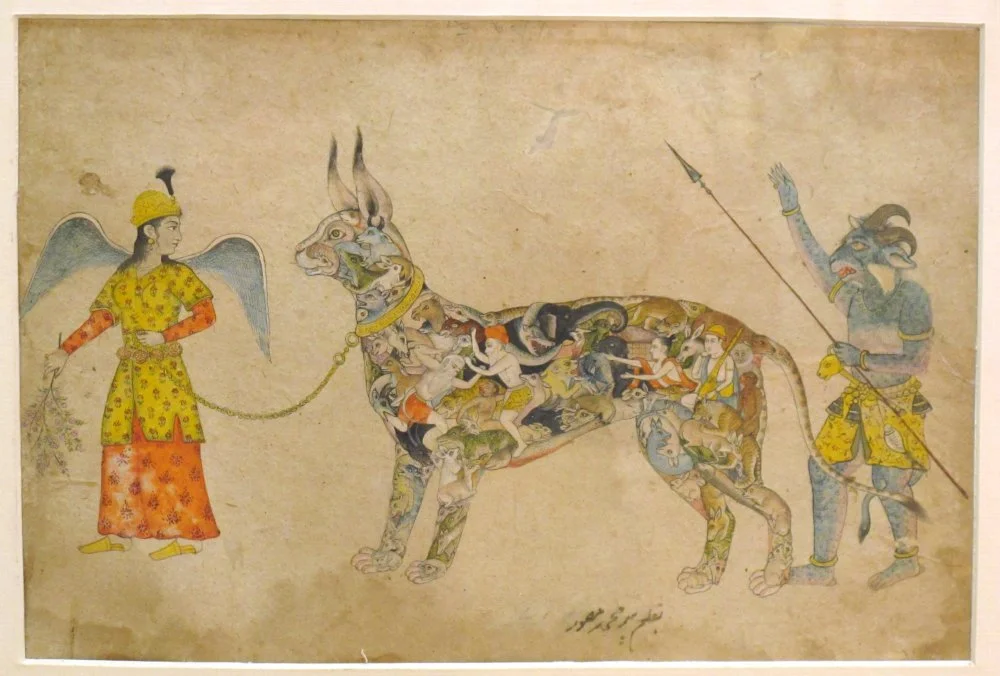
Пары (немесе Пері). XIX ғасыр, Бхопал Археологиялық музейі/Wikimedia Commons
Пері қыздардың тағы бір ерекшелігі — оларды ренжіткен адамды қарғыспен жазалайды. Эпоста «Олардың тілінде мөр бар» деп жазылады, (бұл сүйел, белгі болуы мүмкін). Осылай деп қарғысқа қабілеттіліктерін айтады. Бірде Айчүрөк Семетейге қарғыс айтады. Семетей оның әкеңнің бейітіне құрбандық шалуға бармай-ақ қой дегеніне құлақ аспайды. Айчүрөк болса күйеуінің үзеңгісінен тартып жалынады, аттың үстінде отырған Семетей оны қамшысымен осып кеп қалады. Содан кейін ол мұндай қатігездікке қаны қайнап, қарғыс айтады. Тек дана Қаныкей ғана келінін сабырға шақырып, қарғысты қайтарып алғызады. Уақыт өте келе пері қыздар адамдар арасында ұзақ өмір сүріп, ана атанып, сиқырынан айырылып, қарапайым әйелдерге ұқсап өмір иірімдерін өткереді.

«Манас» жырына жасалған иллюстрация. Г.Петров. 1956/РИА Новости
БАТЫР ҚЫЗДАР
«Манастағы» әйелдердің үшінші түрі — батыр қыздар. Осы әйел кейіпкерлер эпостың қаһармандық кезеңінде көбірек көрініс табады. Батыр қыздардың бейнелері Батыс пен Шығыстың көптеген халық эпостарында, мифтерінде, аңыздарында кеңінен таралған, В.М. Жирмунскийдің пайымдауынша, әйелдердің қоғамдағы орны бұрын неғұрлым тәуелсіз болғаны туралы куәландырады.
«Манас» эпосында Манастың (С. Орозбақов) бәйбішесі болған, қалмақ ханы Қайыптың қызы Қарабөрікті де батыр қыздар қатарына қосамыз; Айчүрөктің өтінішімен Семетейге әйел болған күң Куялы (С. Қаралаев); Манас өлген соң о дүниеде жар болуға уәде берген қалмақ ханы Қайыпдаңның қызы, батыр қыз Сайкал (С. Қаралаев); Манастың қарындасы — Кардыгач; Сейтектің келіні — Ақбермет (С. Қаралаев).
Ақырында, бас кейіпкер Қаныкей (Бұхар билеушісі Темірқанның қызы) дастаншы С. Қаралаевтың айтуы бойынша, ол да қыз күнінде батыр болған. Қырғыз батырларының ішінен онымен бірінші болып соғысқан Чубак бай Бұхар қаласын басып алуға бел буады. Бірақ Каныкейдің мықты әскері тойтарыс беріп, Чубактың меселі қайтып қалады. Дұшпанына дес бермейтін Қаныкейге қызыққан Чубак батыр қыз туралы Манасқа айтып барады да, көп ұзамай оған құда түсуге ұйғарады.
Жалпы, ер киімін кию, қолаң шашын қалпақ астына тығып қою немесе желкесіне түйреп қою секілді әдет-ғұрып түркі-моңғол эпосының батыр қыздарына тән. Мұндай формулалардың түрленуін Қаныкейді суреттеген тұстарынан көруге болады:
Ұрғашы басым ер қылып,
Қыз басымды шер батыр қылып,
Жалбыраған қу шашты,
Төбеме буып-түйгенмін,
Қанішер киім кигенмін.
Орыстың батырлар эпосындағы поляницалармен, яғни батыр қыздарымен салыстырғанда қырғыздың батыр қыздарының бейнесі күрделірек. Осылайша, поляницалар «аға батырлар» туралы архаикалық циклдерде кездеседі және осы түрдің ең ерте түсіндірмесін сақтап қалды. Зерттеуші Р.С. Липец былай деп жазды: олар ер батырлармен бірге шайқасқа «өз күштерін көрсетіп, жауынгерлік артықшылығын дәлелдеу» үшін шығады. Батырмен жекпе-жекте жеңілсе, поляницалар ерлік қасиеттерінен айырылып, олардың «жаулап алған әйеліне» айналады.
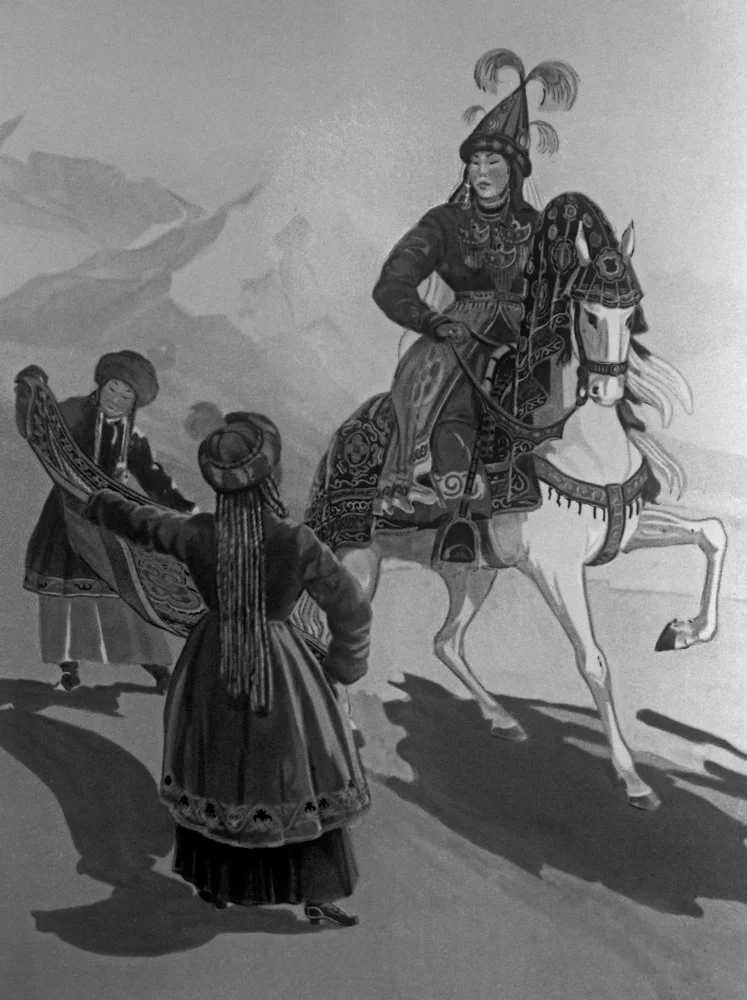
“Манас” жырына жасалған иллюстрация. Г.Петров. 1956/РИА Жаңалықтары
Мысалы, Дунай өзінің күшін айтып шектен тыс мақтанғанына Настася Микулична былай деп өжет жауап қайтарды: «Менің сенен еш жерім кем емес. Қуатым да басым, айла-тәсілім де мықты».
Бұған қарағанда қырғыз эпосының батыр қыздары ешкімге соқтығысып, келеке қылмайды. Олардың бар мүддесі — Отанын қорғап, халқы мен жерін азат ету. Олардың бәрі де ата-бабасының аяулы қызы, ру атын асқақтау жолында адал қызмет еткен. Эпикалық трилогияның үшінші бөлімі «Сейтекте» Куялы қаһарманның сюжеттік қақтығысы өте айқын көрінеді. Бұл қаһарман қыздың портретінде оның табиғатының алып күші мен батылдығын дәстүрлі құралдармен әсірелей суреттеген:
Кайыпчал кызы Куялы
Арстан экен бу дагы.
Ургаачынын шери экен,
Дайрадан ичи кең экен.
Калпагынын кашаты
Он эки кучак сере экен.
Көргөн адам баарысы
Куялы балбан дейт экен
Қазақша жолма-жол аудармасы:
Кайыпчал қызы Құялы,
Арыстан екен бұл дағы.
Ұрғашының шері екен,
Дариядан іші кең екен.
Қалпағының жиегі
Он екі құшақ сере екен.
Көрген жанның барлығы,
Құялы балуан дейді екен.
Оның керемет күші туралы естіген Айчүрөк көмек сұрауға шешім қабылдайды. Қырғыздардың жерін талқандауға келген Сарыбай дәуге қырғыздың үш батыры — Семетей, Күлчоро, Сейтек шыдай алмай, отыз күн, отыз түн соғысады. Бірақ Куялы көмектеспес бұрын «Семетей маған үйленсін» деп шарт қояды. Дана Айчүрөк себебін түсінгендіктен келіседі. Өйткені батыр қыз өз руын қорғау қажеттігін жан-тәнімен сезінеді.

Манас жырына жасалған иллюстрация. Герцен Теодор Теодорович 1935-2003 , 1972/National Museum of Fine Arts Gapar Aitiev
ЕЛ ІШІНДЕГІ БИКЕШТЕР
Эпостың кейінгі кезеңінде біз шартты түрде «ел ішіндегі бикештер» деп атаған әйел бейнесінің жаңа әрі соңғы түрі пайда болды және бұл халықтың неке үлгісі туралы идеяларын қалыптастырумен байланысты. Оның ажырамас атрибуты, ең алдымен, әйелінің күйеуіне деген адалдығы. Сондай-ақ тіпті төркін халқын қырып, жеңіп келген жұбайына кектенбейді де. Халық ұғымындағы мұндай неке қыздың ата-анасына ірі көлемде қалыңмал төлей отырып, екі тәуелсіз тараптың да бейбіт келісіміне негізделген. Шын мәнінде, қалыңдықтың жаңа нақты эпикалық түрі жасалды. Ол С. Орозбаков эпосының сюжетінде Қаныкей (Санирабиға) бейнесінен айқын көрінеді.
Жыршы тыңдарманға батыр қызды сонау Қыйбада ұлына қалыңдық іздеп жүрген Жақып қарттың суреттеуімен таныстырады. Мына бір үзінді де эпикалық сұлулықты сипаттауға тән әдеттегі поэтикалық эпитет бар:
Санирабига қыз екен,
Хас сұлудың өзі екен.
Анық айтып, шыңқ етіп,
Ақылы толған кезі екен.
Он алты жарым жасы бар,
Қолаң қара шашы бар.
Сары алтындай, түймедей
Келісті қара қасы бар.
Ала шапан киініп,
Ботадай белі иіліп,
Шидей қасы сызылып,
Арқасы қайқы, арқар төс,
Ай шырайлы бота көз,
Қызыл жүзі нұрланған,
Қыпша белі бұралған.
Тіпті түркі-моңғол эпосының, соның ішінде қырғыздың «Манасының» батырлық ертегілерін тұңғыш жинаушы В. Радловтың өзі «Манас» эпостық жырларын тыңдаушылардың қабылдауындағы бір маңызды жағдайды, яғни олардың Сібір мен Алтайдағы түркі халықтарындағы эпостық жырларды тыңдаушылардан айырмашығын аңғарды:
«Қырғыздар жырларында әлдебір ғажайып, сұмдық дүниедерге басымдық бермейді, керісінше, жыр арқылы өз өмірін, өз сезімін, ұмтылысын дәріптейді; қоғамның әрбір мүшесінің ішінде өмір сүретін сол идеалдар. Тыңдаушыларға ләззат беретін орасан зор немесе таңғажайып дүние емес, табиғилық пен шынайылық бар».i
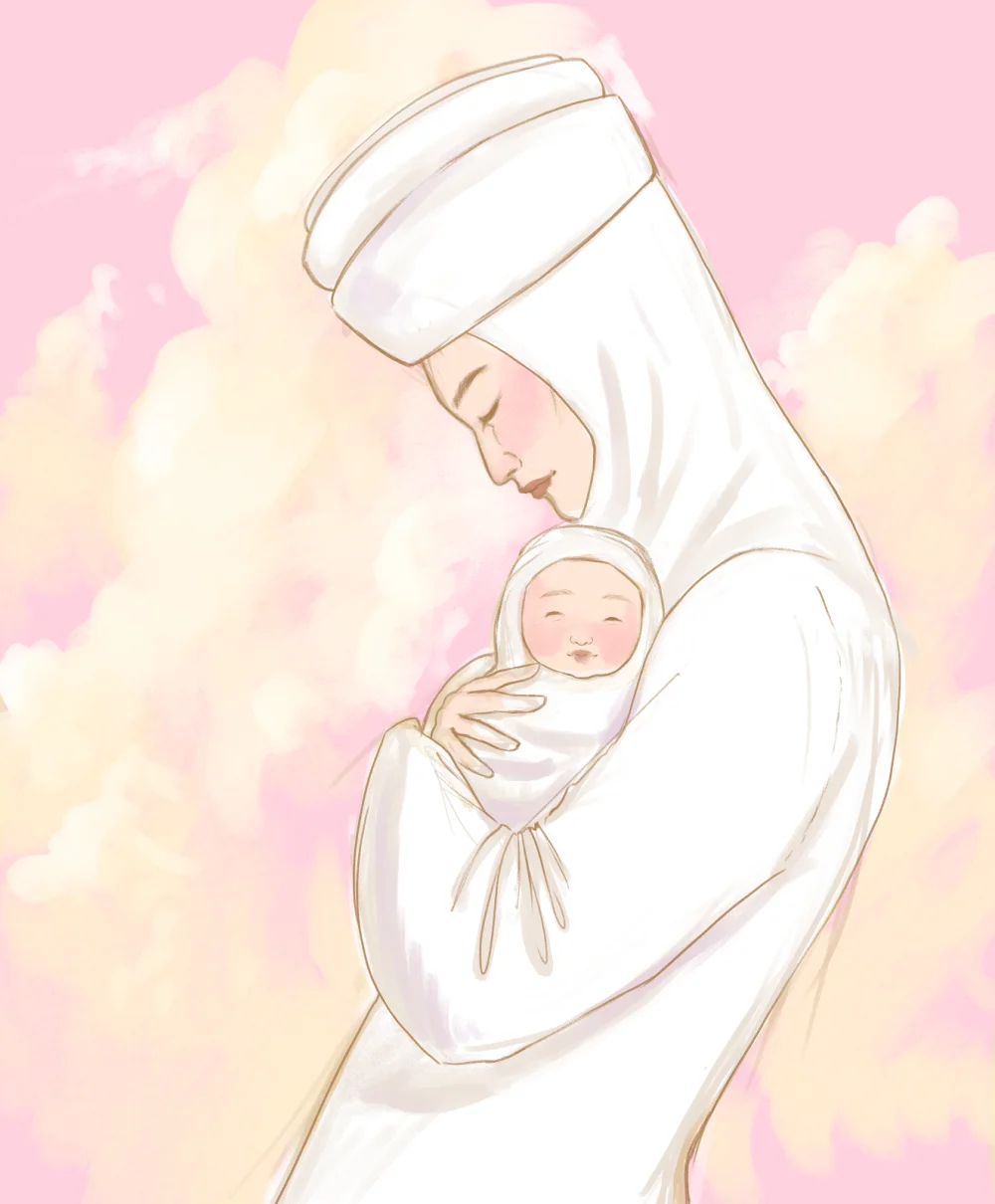
Ана бейнесі/Qalam
Батырдың қарапайым келіншегі, одан кейін әйелі мен анасы Қаныкей бейнесі эпостың сан алуан кейіпкерлеріне толық сәйкес келеді. Қарапайым қалыңдықты дәріптеу тақырыбы — көшпелі өмірдің қиын кезеңінде және толассыз соғыс жағдайында халық бағалаған әйел мінезінің қарапайым қасиеттерінің жиынтығы. Олар, сайып келгенде, тұрақты гуманистік идеалдарға сәйкес келетін адамзатқа ортақ адамгершілік құндылықтарды айшықтайды. Жыршының ақындық мәнерінің ерекшелігі — қыздың сыртқы келбетінен аңғарылатын жан дүниесінің қасиеттерін асыра суреттеуінде жатыр:
Аман болса алғаны
Жаман деп кісі айтпаған,
Сыйлы болар кісі екен.
Алғанынан айырылса,
Ұзын кірпік, тұнық көз,
Жылап тұрар кісі екен.
Жақып Қаныкейдің намысшыл да табанды мінезін танып, оның байсалды, дана сөзін түсініп, күйеуінің нағыз тірегі болатынын аңғартады. Қаныкей биік өскен бұтақтан бір жемісті алып, оны достарының барлығына тең бөліп, одан кейін үзілген ойынды жалғастырып жатқанын Жақып бұтаның ар жағынан ұзақ бақылап тұрады. Болашақ келіннің тапқырлық пен іскерлік, бәріне бірдей көңіл бөлу, ортақ іске бағыт-бағдар бере білу сияқты қасиеттері көреген қарияны бейжай қалдырмады. Ол жанқиярлығымен, жомарттығымен және айналасындағы адамдарға ерекше ілтипатымен, барлығына бірдей көрсеткен қамқорлығымен ерекшеленеді. Оның сондай ұқыптылығы жан дүниесінің тазалығын да білдіреді:
Кірпіктей кір жұқтырмай,
Бойын сылап тараған,
Бастан аяқ ұқыптап,
Жыртық қоймай қараған.
Үй иесі, шаңырақтың жылуы ретінде әйел бойынан табылуы керек қасиет — киіз үйдің табалдырығынан аттаған әр адамды сыпайылық танытып, қонақжайлықпен қарсы алуы. Өйткені көшпелі қоғамның нормалары бойынша ауа райының қолайсыздығы мен мезгілсіз уақытта, шаршап-шалдығып келген жолаушыға үйдегі барды ұсынып, құрмет көрсету салты болған:
Жаман-жақсы бөлмеген,
Жаманды күткен жақсыдай,
Жақсыны күткен бақсыдай,
Бақсыны күткен қожадай,
Қожаны күткен бұрында
Падишасы болғандай.
Жігітті күткен еріндей,
Ерге қылар қылығы
Жаңа түскен келіндей.
Бір қызығы, мұнда табиғатынан дана, ақылды адамның басқа адамға рухын көтеруге, өзін қадірлі әрі жайлы сезінуге көмектесетін ең асыл қасиеті айтылады. Адам психологиясының өте тереңдігі және сезімталдығы жырланады.
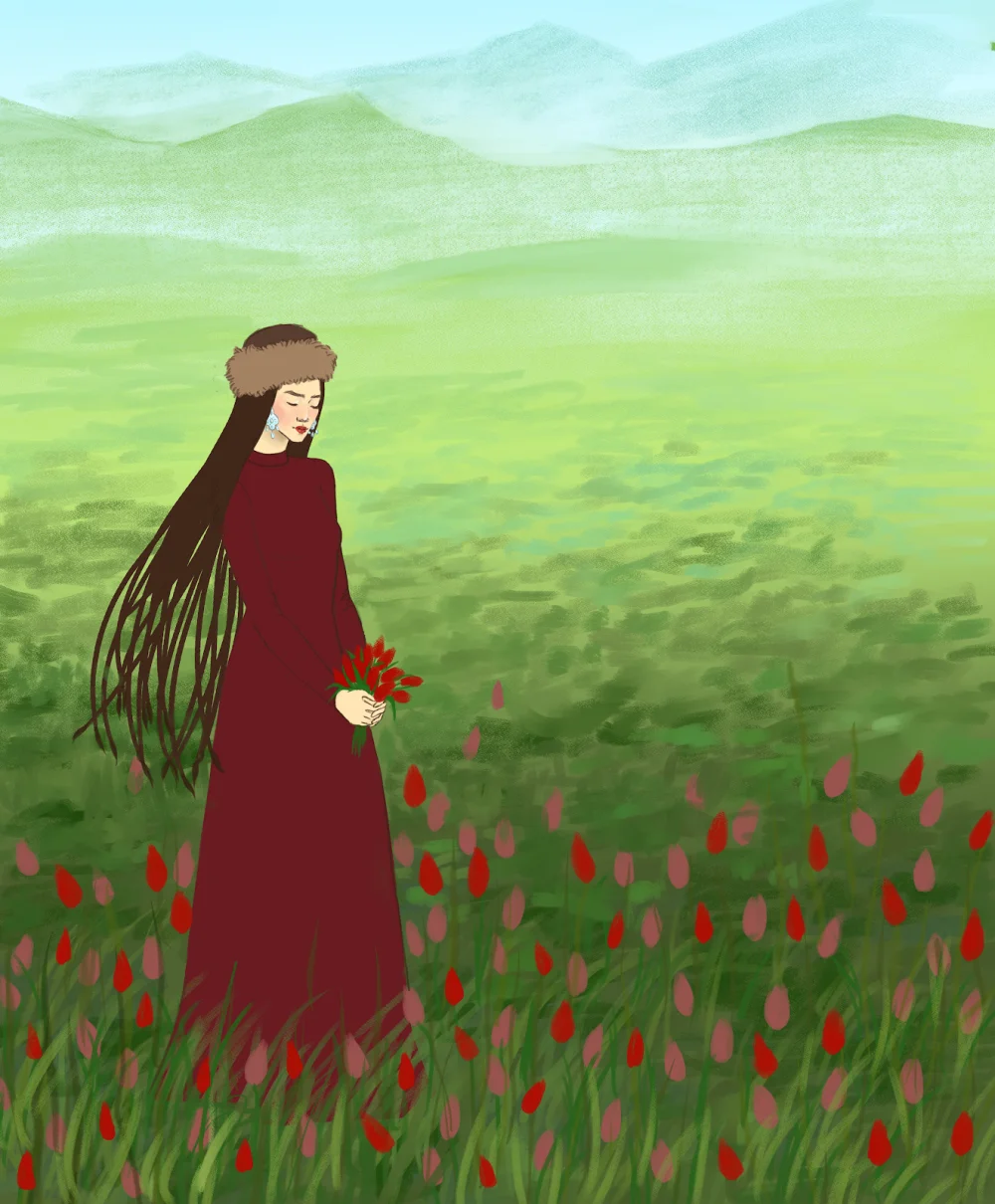
Қаныкей/Qalam
Ерекше бейнелеуіш формулалар арқылы ақыл, парасат, даналық қасиеттеріне баса назар аударады. Каныкейді оның алдындағы қалыңдықтардың бейнелерінен ерекшелендіретін жаңа нәрсе — жыршының айтуынша, білімі болды. Жақып Кыйбуға келіп, жергілікті тұрғындардан тәуліктің белгілі бір уақытында қалада барлық жергілікті қыздар мешітте оқитынын, оларға әртүрлі жастағы тәжірибелі тәлімгерлер тағайындалғанын естиді. Қыздар арасында Кыйбу билеушісінің қызы Санирабиға оқитынын біледі, яғни мінсіз әйелдің атрибуты зор білім саналған.
Бірақ ең жоғары бағаланатын сапа — бұл еңбекқорлық, қажетті, пайдалы заттарды жасай білу, сонымен бірге шеберлік. Кыйбу маңында, өзен бойында үйлену тойларын өткізу үшін ақ киізбен жабылған қырық киіз үй орнатылды. Ата-аналардың таңданысы бойынша, Каныкей достарымен бірге бос уақытында қолөнермен айналысқанын біледі, ерлер мен әйелдердің киімдерін, көрпелер мен жастықтарды, кілемдер мен төсек жапқыштарын тігіп, кестелеп, тұрмысқа қажетті үй ыдыстарын жинаған. Қайырымдылық жинағаны сонша — олар оны қырық ерлі-зайыптыларға сыйға тартқан.
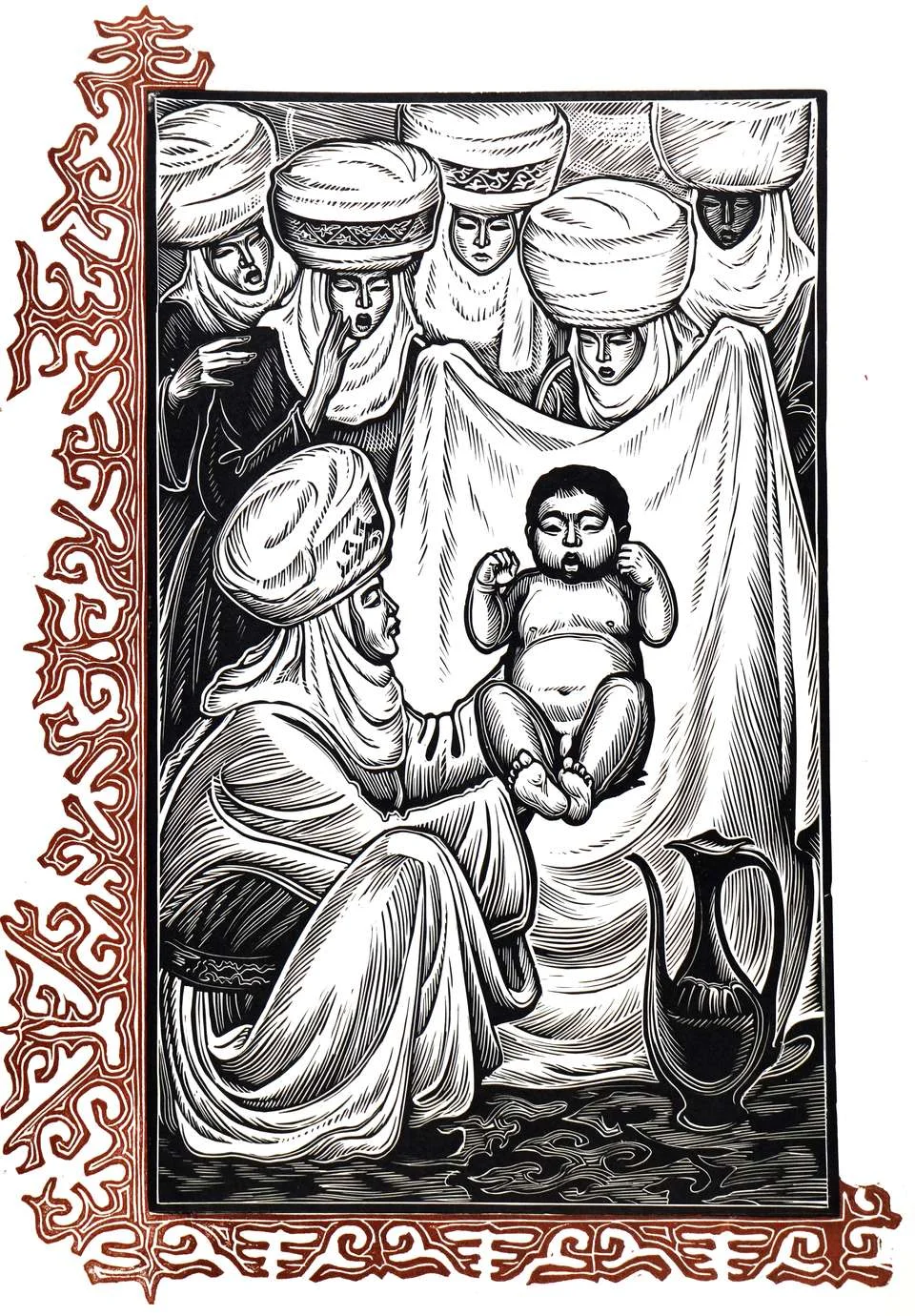
Герцен Теодор Теодорович 1935-2003 , 1972/National Museum of Fine Arts Gapar Aitiev
Қаныкейдің әйел мен ана ретіндегі бейнесін манасшы С. Орозбаковтың түсіндірмесінде ашу, өкінішке орай, белгісіз, өйткені жинаушылар оның «Семетей» эпосының нұсқасын жазып үлгермеді. Жырды жеткізуші С. Қаралаевтың баяндамасын қолданамыз.
Ежелгі заманнан бері әлемнің түкпір-түкпірінде ана әйел үлкен құрметке ие болды. Әйелді құрметтеу ананы құрметтеумен тең еді. Л.Н. Гумилев «Ежелгі түріктер» атты зерттеуінде былай деп жазды: «Әйелге деген құрметті көзқарас рыцарлық деңгейде бағаланды. Киіз үйге енген ұлы алдымен анасына, содан кейін әкесіне тағзым еткен. Орхон жазба ескерткішінде Күлтегіннің орданы қорғаған шайқасын, өлім қаупі төнген туыстары болғанын барынша пафоспен суреттейді. Гиндукуш патандары сияқты құқығы жоқ халықтардың арасында жаулары әйелдер өлтірмейтін болған... Әйелдердің мұрагерлік және жоғарыдағы жазба мәтіндерінен көп әйел алудың болғанын болжай аламыз, бірақ бұл да түркі әйелінің хақын жоққа шығарған жоқ».i
Қаныкей ана бейнесінің типологиялық тамыры құдай-аналар туралы архаикалық идеялардан бастау алады. Біз ана сүтінің тылсым қасиеттеріне деген сенімдердің сарқыншақтарын кездестіреміз. Таласқа қайтып оралған Қаныкей Семетейге бауыр қылып егіз ұлдар Күлчоро, Канчороны дүниеге әкелгісі келіп, Аан Алахчын, Айехсыт, Иехсыт (якут олонхо) тәңірлері сияқты оларды ана сүтімен тамақтандырады. Бірақ Канчоро тойғанда пайда болған ұйыған қара қаннан Қаныкей оның бойындағы сатқындық қасиетін танып, оны өлтіруді талап етеді. Алайда адамдар енді белгілерге сенбейді және Канчоро аман қалады. Бірақ кейін бәрі де дәл Қаныкей болжағандай болады.
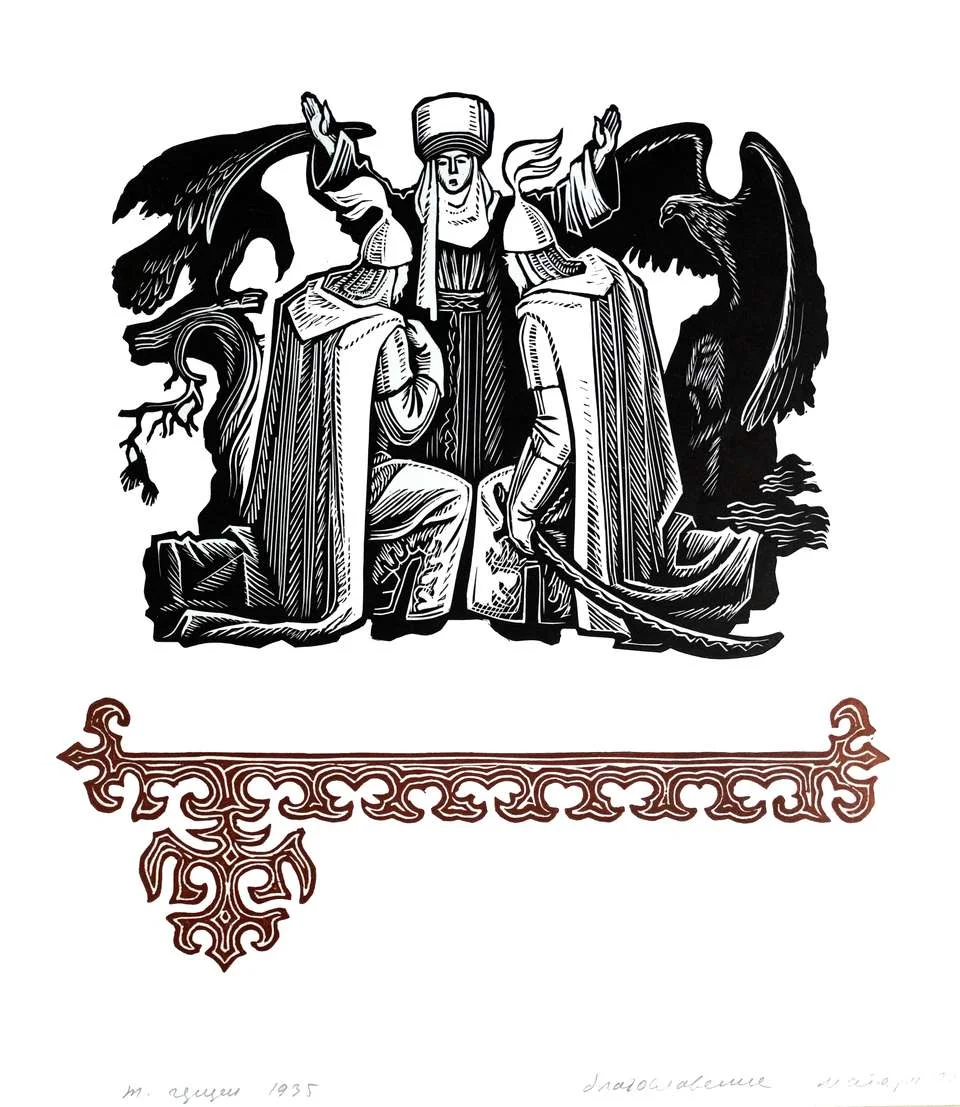
Герцен Теодор Теодорович 1935-2003 , 1972/National Museum of Fine Arts Gapar Aitiev
Құдай-аналардың тағы бір ерекшелігі — қырғыз эпосының сюжетінде батырды қайта тірілту. Тағы да ежелгі мифтердің бірінде Семетей тау-тасты кезіп он екі жыл қаңғырып, кейін көрінбейтін «кайып» болып кетеді, сонда Қаныкейдің ана сүтінің көмегімен адамдар әлеміне оралады.
Алайда ежелгі мифологиялық мотив бойынша құдай-аналар батырларға қару-жарақ пен ат беріп, жаңа дем беруі қырғыз эпосында толығымен шынайы тарихи түрде көрініс табады.
Мәселен, «Үлкен жорықтың» алғашқы эпизодтарында жауынгерлердің отбасыларымен қоштасу көрінісі сипатталған. Манас әскерімен бірге Қаныкеймен қоштасу үшін ауылға оралған, онда күтпеген жерден әр жауынгер барлық ауа райына арналған аяқ киім мен киім, жауынгерлік сауыт пен дулыға, оқ пен мылтық салынған сөмкелер, барлық қару-жарақ, дәрі-дәрмектер және «күл-азық» (сиқырлы азық) алды. Жауынгерлердің таңданысы мен қуанышында шек болмады. Осы сәттен бастап Қаныкей «халықтың анасы» («калк энеси Каныкей») ретінде танылды.
Каныкей тек өз қолынан тігіп қана қоймай, қажетті заттардың күрделі және ауқымды өндірісін ұйымдастыра білді, ұсталар мен аңшыларды, былғары өңдеушілерді, тігіншілер мен қолөнершілерді, аспаздар мен емшілердің басын қосты. Негізінде, біз бұдан топ-менеджер-әйел басқаратын қолөнер өндірісінің шынайы бейнесін көре аламыз.

Манас жырына жасалған иллюстрация. Герцен Теодор Теодорович 1935-2003 , 1972/National Museum of Fine Arts Gapar Aitiev
Ертедегі қаһармандық эпостың құдай-аналар сияқты, Қаныкей де батырға ат тарту еді. Бұл Семетейге арналған Тайторуу жылқысы еді. Алдымен ол саяпкердің қолөнер шеберлігін көрсетеді, яғни ол жылқыны құлын кезінен өсіріп, баптап, жаратып, мініске үйретеді. Ол Манастың қылышын, Алмамбеттің мылтығын, әскери шапанын — Аколпок сауытын сақтап және оларды Таласқа оралғанда осының бәрін ұлына табыстайды.
Ананың ең маңызды қасиеті — жақын туыстары биліктің бұйрығымен өлім қаупі төнген баласын қауіптен қорғау; ұлын сау және мықты етіп тәрбиелеу, әкесінің ізбасарын өсіру — өз халқын қорғауға баулу, жат қолына құл болуына жол бермеу. Мұның бәрін Қаныкей өзінің аналық сезімімен, сүйіспеншілігімен, шыдамдылығымен жүзеге асыра алды. Манас қайтыс болғаннан кейін оның өмірі оңай болмады, кейде шыдатпас қиындықтар келді. Бұл сюжеттік мотивтер трилогияның «Семетей» атты екінші бөлігінің эпизодтарында шоғырланған. Қаныкейдің ойларын мен сын-сағатын уайым-қайғысын жеткізу үшін манасшы С. Қаралаев халық ән лирикасының шығармашылық элементтерін, яғни армандарды (қайғылы әндер) мен кошоктарды (жоқтау ән) пайдаланады, олар бейнеге ерекше психологизм үстейді әрі классикалық романның кейіпкерлеріне жақындатады.
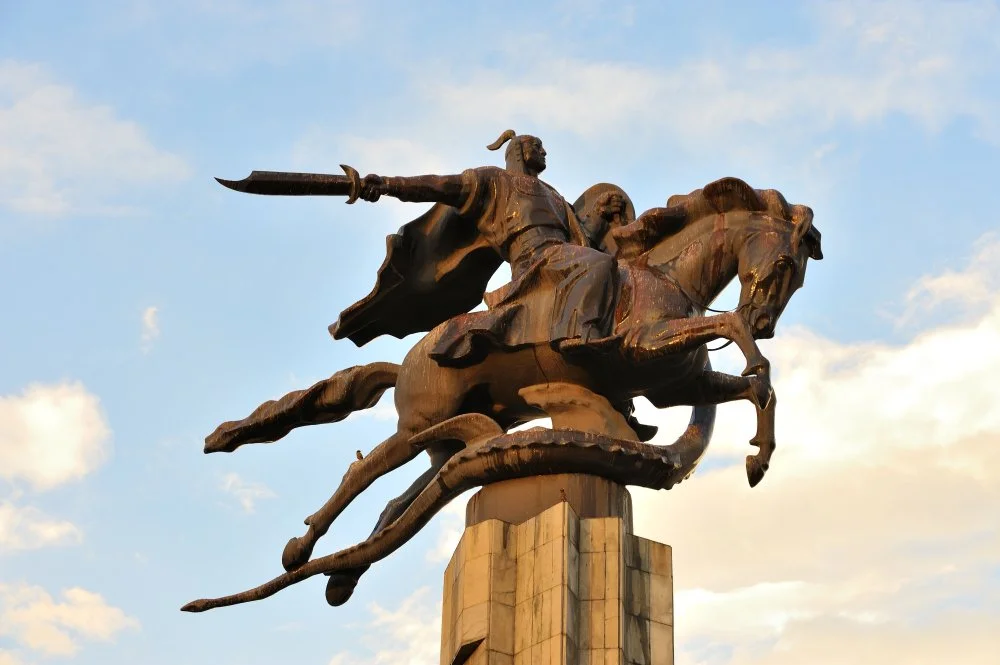
Манас, Қырғыз эпосының кейіпкері/Alamy
Әр халықтың өз жерін, өлкесін дәріптейтін асыл сөздері, ән-жыры бар. Табиғатқа, өз жерінің пейзажына сүйсіну — туған жерге, туған өлкеге деген сүйіспеншілікті білдірудің бір жолы. Ал эпостағы мұндай жолдар Қаныкейдің аузымен жырланады. Табиғат-Ана архетипі Отан бейнесіне немесе Қаныкей тағы бір аты «Халық анасына» айналғандай және бұл метаморфоза әйел тегінің жаңа анықтамасы іспетті:
Біздің Талас қайран жер,
Тауларында қары бар,
Тоғайында қарға бар,
Шыбықтары шынардай,
Шынарлары мұнардай.
Шымшықтары ұлардай.
Бұлағы қайнап тасыған,
Бұлбұлдары қосып ән.
Беткейден бұлбұл сайраса,
Мұңайып пенде жасыған.
Алма шіріп көң болған,
Адамзат пендеге
Лайықты жер болған.
Шие пісіп сай болған,
Жайлаған қырғыз бай болған.
Құндызы суда ойнаған,
Тауында қарсақ шулаған,
Төңіректен жел болған,
Қайран жерім кең Талас,
Ата қоныс жер болған.
ОҚУҒА ҰСЫНАМЫЗ:
Абрамзон С.М. Рождение и детство кыргызского ребенка // Сб. МАЭ, ХII, 1949.
Жирмунский В.М. Народный героический эпос. Сравнительно-исторические очерки. — М.-Л.: Гослитиздат, 1962.
Липец Р.С. Стадиальная изменчивость образа богатырки в тюрко-монгольском эпосе // Международный конгресс монголоведов. Улан-Батор. 1987. — М.: Изд-во ин-та этнографии и истории АН СССР, 1987. С. 192–198.
Радлов В.В. Предисловие // «Манас» — героический эпос киргизского народа. — Фр.: Илим, 1968. С. 6–24.
Гумилев Л.Н. Древние тюрки. — М.: Наука, 1967.
